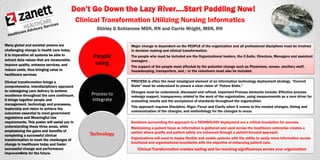Ania 2013 poster zanett_final_2 people_process_technology
- 1. Clinical Transformation Utilizing Nursing Informatics Many global and societal powers are challenging change in health care today. It is imperative all systems be able to extract data values that are measurable; improve quality, enhance services, and reduce costs, thus bringing value to healthcare services. Clinical transformation brings a comprehensive, interdisciplinary approach to redesigning care delivery to achieve excellence throughout the care continuum. It brings together people and management, technology and processes, leadership and vision to achieve the outcomes essential to meet government regulations and Meaningful Use requirements. This poster will assist you in understanding these three areas, while emphasizing the gains and benefits of completing a successful clinical transformation to meet the challenges of change in healthcare today and foster successful change and performance improvements for the future. Major change is dependent on the PEOPLE of the organization and all professional disciplines must be involved in decision making and clinical transformation. The people who must be included are the Organizational leaders, the C-Suite, Directors, Managers and assistant managers . The support of the people most affected by the potential change such as Physicians, nurses, ancillary staff, housekeeping, transporters, and / or the volunteers must also be included. Decisions surrounding the approach to a TECHNOLOGY deployment are a critical foundation for success. Maintaining a patient focus as information is gathered and used across the healthcare enterprise creates a system where quality and patient safety are enhanced through a patient-focused approach. Organizations will need to deploy flexible and usable systems with the ability to easily move information across functional and organizational boundaries with the objective of enhancing patient care. Clinical Transformation creates lasting and far-reaching significances across your organization Shirley G Schiavone MSN, RN and Carrie Wright, MSN, RN PROCESS is often the most misaligned element of an Information technology deployment strategy. ŌĆ£Current StateŌĆØ must be understood to ensure a clear vision of ŌĆ£Future State.ŌĆØ Changes must be understood, discussed and refined. Important Process elements include: Effective process redesign support, transparency related to the work of the organization, using measurements as a core driver for evaluating results and the acceptance of standards throughout the organization. This approach requires Discipline, Rigor, Focus and Clarity when it comes to the needed changes, timing and communication of the changes, and methodology for the changes to occur.

